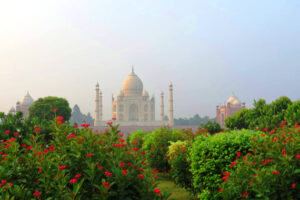
Mehtab Bagh (Moonlight Garden) is a charbagh complex in Agra, North India. It lies north of the Taj Mahal complex and the Agra Fort on the opposite side of the Yamuna River, in the flood plains.The garden complex, square in shape, measures about 300 by 300 metres (980 ft × 980 ft) and is perfectly aligned with the Taj Mahal on the opposite bank. During the rainy season, the ground becomes partially flooded.
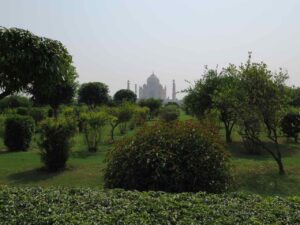
The Mehtab Bagh garden was the last of eleven Mughal-built gardens along the Yamuna opposite the Taj Mahal and the Agra Fort, the first being Ram Bagh. It is mentioned that this garden was built by Emperor Babur. It is also noted that Emperor Shah Jahan had identified a site from the crescent-shaped, grass-covered floodplain across the Yamuna River as an ideal location for viewing the Taj Mahal.
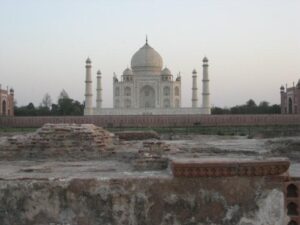
It was then created as “a moonlit pleasure garden called Mehtab Bagh.” White plaster walkways, airy pavilions, pools and fountains were also created as part of the garden, with fruit trees and narcissus. The garden was designed as an integral part of the Taj Mahal complex in the riverfront terrace pattern. Its width was identical to that of the rest of the Taj Mahal.
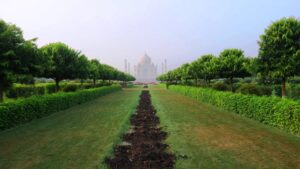
It was ingeniously planned on one main level. First, a large octagonal tank of brick masonry, each internal side of which measured 26.70 M. (Approx. 80 feet), was built each side had 16 scalloped arches, to make up a beautiful border of the tank, on its South, West, North and East sides were spacious bungalow (Pavilions with curved chhajjas and roofs) which were interconnected by wide dalans or covered corridors, on other sides. All these were built of red sandstone, and engrailed (cusped) arches, pillars, carved panels and other architectural parts of this vast structure, in typical Shahjehanian style, have survived in the ruins. There were 25 fountains in the tank. These were inlets of water which was supplied by overhead tanks through water-tight terracotta pipes, which have all disappeared. On its Northern side is an oblong red stone tank, with scalloped corners. Water from the main octagonal tank flowed through a slit under the Northern Bungla, and fell into this ob-long tank in the form of a water-fall (Abshar), behind which a Chini-Khanah (Series of Niches for candles in the night and flower guldastas in the day) is provided.
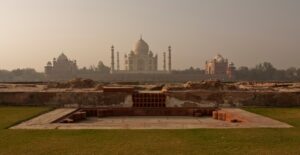
A large Char-Bagh (Four-Quartered Garden) was laid out on its northern side. It was divided into four quarters, with a square lotus-tank in the centre. It also has scalloped corners, shallow stone canals with stone-paved pathways on both sides, now extinct, were built from this central tank to the middle of the four sides. Water flowed from the main tank to the ob-long tank and thence to the canals of the garden. There were Barahdaris (open, arcaded pavilions) on the Western, Northern and Eastern sides of the Char-Bagh. These too have been destroyed. The enclosing wall has also disappeared and only its river-side, south-eastern tower has remained. Aurangzeb, in his letter dated 8 Muharram 1063 Hijri (9 December 1652 A.D.) mentioned Mahtab-Bagh and noted that it was recently submerged under flood water, But the octagonal tank and bunglas had remained unaffected. In the later ages, the buildings collapsed and the garden was covered by sand deposited by river floods, and it was forgotten.
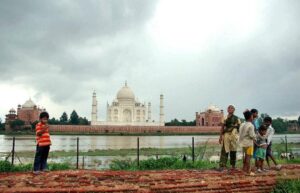
Archaeological excavations in the Mehtab Bagh site have been described as “setting new archaeological standards for Mughal garden research”, using paleobotanical and excavations techniques. Excavations to the extent of 90,000 cubic metres of earth were carried out by the Archaeological Survey of India (ASI), in 1994. The excavations unearthed a large octagonal tank with 25 fountains, and a garden, divided into four compartments. Mumtaz Mahal’s tomb was found to be situated halfway between the Taj Mahal complex’s main entrance and the ends of the Mehtab Bagh site.
ASI landscape artists meticulously planned the replanting of trees, plants and herbage to match the original Mughal gardens, replicating the riverside gardens brought to India from Central Asia in Shalimar Bagh in Kashmir. Some 81 plants adopted in Mughal horticulture were planted, including guava, maulshri, kaner, hibiscus, citrus fruit plants, neem, bauhinia, ashoka and jamun. The herbage was planted in such a way that tall trees follow the short ones, then shrubs, and lastly flowering plants. Some of these plants produce bright-coloured flowers that shine in the moonlight. The park has been reconstructed to its original grandeur and has now become a very good location to view the Taj Mahal.
Source
https://en.wikipedia.org/wiki/Mehtab_Bagh
http://www.adfagra.org/monuments-of-agra/mehtab-bagh/
https://www.indianholiday.com/tourist-attraction/uttar-pradesh/gardens/mehtab-bagh-agra.html
https://hooolycow.wordpress.com/
http://www.trekearth.com/gallery/Asia/India/North/Uttar_Pradesh/Agra/photo1211664.htm
http://blog.world-mysteries.com/mystic-places/black-taj-mahal-the-emperors-missing-tomb/
http://www.fullstopindia.com/mehtab-bagh-taj-mahal-viewing-spot/


